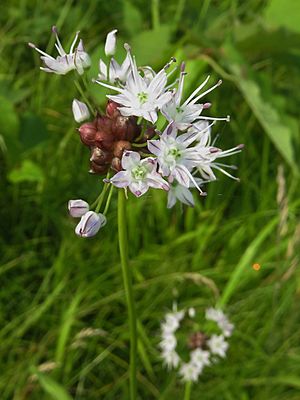Long-stamen chive facts for kids
Quick facts for kids Long-stamen chive |
|
|---|---|
 |
|
| Allium macrostemon, Tanesashi Coast, Aomori Prefecture, Japan | |
| Conservation status | |
| Scientific classification | |
| Genus: |
Allium
|
| Species: |
macrostemon
|
| Synonyms | |
|
|
Allium macrostemon is a type of wild onion also known as Chinese garlic, Japanese garlic, or long-stamen onion. It grows naturally across a large part of East Asia. You can find it in many areas of China, as well as Japan (including the Ryukyu Islands), Korea, Mongolia, Tibet, and Primorye in Russia. This plant can grow in many different places, from sea level all the way up to 3,000 meters high in the mountains.
Contents
What Does Allium macrostemon Look Like?
Allium macrostemon grows from a single round bulb that can be up to 2 centimeters (about 0.8 inches) wide. The main stem, called a scape, can grow up to 70 centimeters (about 27.5 inches) tall.
Leaves and Flowers
The leaves of Allium macrostemon are shorter than its stem. They are long and hollow, and if you cut them, they would look round or have three sides. The plant produces a large, crowded cluster of flowers called an umbel. These flowers are usually a pale red or a light purple color.
Historical Uses of Allium macrostemon
Allium macrostemon has been known and used for a very long time. It is mentioned in an ancient Chinese medical text called the Huangdi Neijing, which is also known as The Yellow Emperor's Classic of Internal Medicine.
One of Five Important Herbs
In this old text, Allium macrostemon is listed as one of the "five consumable herbs" (五菜). These five herbs were important plants used for food or medicine. The other four herbs mentioned alongside Allium macrostemon were:
- Mallow (Malva verticillata)
- Pea leaves (藿)
- Welsh onion (蔥)
- Garlic chives (韭)
See also
 In Spanish: Allium macrostemon para niños
In Spanish: Allium macrostemon para niños


